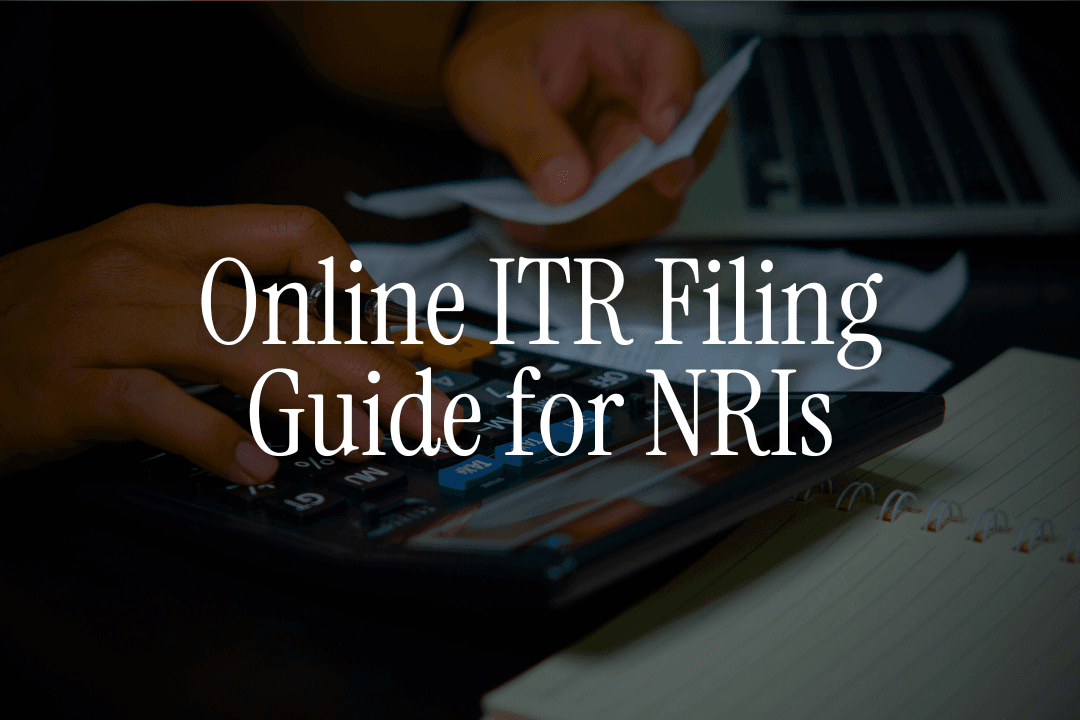
You're sitting in your Dubai office, and WhatsApp is buzzing with messages about ITR filing deadlines. Your friend just got slapped with a penalty notice for late filing. Your CA back in Mumbai is asking for documents you don't even know you need.
Sound familiar?
Here's the thing: if you're earning any income from India as an NRI, filing your Income Tax Return (ITR) isn't just a good idea - it's legally mandatory. But most NRIs either mess up the process, choose the wrong forms, or miss out on thousands of rupees in legitimate refunds.
I've spent the last 12 years helping NRIs navigate Indian tax laws. I've seen every mistake in the book - from choosing ITR-1 (which NRIs can't even use) to missing verification deadlines and losing refund claims.
In this guide, I'll walk you through everything: understanding your tax obligations, picking the right ITR form, filing step-by-step online, claiming DTAA benefits, and avoiding the costly mistakes that 90% of NRIs make.
By the end, you'll have a clear roadmap to file your ITR correctly, claim your refunds, and sleep peacefully knowing you're fully compliant.
Understanding ITR: What It Means for NRIs
ITR stands for Income Tax Return - a detailed statement of your income and taxes paid that you submit to the Indian Income Tax Department annually.
Think of it as your financial report card to the Indian government.
For NRIs, ITR serves three critical purposes:
- Legal compliance - Avoid penalties and notices
- Refund claims - Get back excess TDS deducted
- Financial proof - Required for loans, visa applications, and investments
But here's what confuses most NRIs: you're only taxed on Indian income, not your global earnings (unless you're a resident for tax purposes).
👉 Tip: Many NRIs think TDS deduction means their tax job is done. Wrong. You still need to file ITR to claim refunds or report additional income.
Who Must File ITR as an NRI?
Mandatory filing scenarios:
- Indian income exceeds ₹3 lakh (old regime) or ₹4 lakh (new regime)
- Any capital gains from selling property, shares, or mutual funds
- You want to claim TDS refunds
Even if filing isn't mandatory, you should file if:
- TDS was deducted on your interest or rent
- You want to carry forward capital losses
- You need ITR for visa applications or loan approvals
Let me give you a real example: Priya works in Dubai and earns ₹2 lakh from her NRO fixed deposit in Mumbai. Tax isn't due (below exemption limit), but ₹60,000 TDS was deducted. By filing ITR, she can claim a full refund.
Determining Your Residential Status: The Foundation
This is where 60% of NRIs get confused, and it's the most critical decision.
You're a Non-Resident for tax purposes if you stayed in India for:
- Less than 182 days during the financial year, OR
- Less than 60 days in the current year AND less than 365 days in the preceding 4 years
New 120-day rule: If you're an Indian citizen with Indian income above ₹15 lakh, the 60-day limit becomes 120 days.
Why this matters:
- Residents pay tax on worldwide income
- NRIs pay tax only on Indian income
- Wrong classification can double your tax liability
👉 Tip: Maintain a day-count spreadsheet. Include entry/exit dates from passport stamps. WhatsApp location sharing with family can also serve as backup proof.
For detailed guidance on determining your status, check our comprehensive guide on residential status for income tax.
Choosing the Right ITR Form: Critical Decision
Here's a fact that surprises many NRIs: You cannot file ITR-1 (Sahaj). It's only for resident Indians with simple income.
ITR-2: Your Most Likely Choice
Use ITR-2 if you have:
- Salary from Indian sources
- House property income (rent)
- Capital gains (from selling assets)
- Interest from NRO fixed deposits
- Foreign assets above ₹1 crore
- Income requiring DTAA benefits
ITR-3: For Business Income
Use ITR-3 if you have:
- Professional fees from Indian clients
- Business income from India
- Partnership income
Quick Decision Tree:
- Salaried NRI with investments? → ITR-2
- Running a business/consultancy in India? → ITR-3
- Only salary income (no other complexity)? → ITR-2
Essential Documents: Your Filing Toolkit
Mandatory Documents:
- PAN card (linked with Aadhaar)
- Form 26AS (shows all TDS deducted)
- Annual Information Statement (AIS)
- Bank statements for all Indian accounts
- Passport with visa stamps (for day-count proof)
Income-Specific Documents:
- Form 16/16A (salary/TDS certificates)
- Property documents and rent agreements
- Investment statements (mutual funds, shares)
- Interest certificates from banks
- Capital gains computation sheets
For DTAA Claims:
- Tax Residency Certificate (TRC) from your host country
- Foreign tax payment receipts
- Employment contract showing work location
Pro tip: Before you start filing, download your Form 26AS from the IT portal. This shows all TDS deducted and helps cross-verify your income.
Step-by-Step Online Filing Process
Step 1: Portal Access and Login
- Visit www.incometax.gov.in
- Click "e-File" → "Income Tax Returns" → "File Income Tax Return"
- Login with your PAN and password
First-time filer? Register using PAN, mobile number, and email ID.
Step 2: Return Selection
- Assessment Year: Select 2025-26 (for FY 2024-25 income)
- Filing Mode: Choose "Online"
- ITR Form: Select ITR-2 (for most NRIs)
- Status: Individual
Step 3: Basic Information Verification
Confirm your:
- Personal details (name, DOB, address)
- Contact information
- Bank account details (for refunds)
Important: Ensure your Indian address is updated. Many NRIs use their parents' address.
Step 4: Tax Regime Selection
New Tax Regime (Default for AY 2025-26):
- ₹3 lakh exemption limit
- Lower tax rates but limited deductions
- Good for NRIs with minimal Indian investments
Old Tax Regime:
- ₹2.5 lakh exemption limit
- Higher tax rates but more deductions
- Better if you have home loans, insurance, or PPF
Quick comparison:
Income | Old Regime Tax | New Regime Tax |
|---|---|---|
₹5 lakh | ₹12,500 | ₹10,000 |
₹8 lakh | ₹62,500 | ₹40,000 |
₹12 lakh | ₹1,42,500 | ₹1,00,000 |
👉 Tip: If you have home loan interest above ₹50,000 or investments in PPF/ELSS, stick with the old regime.
Step 5: Income Reporting
Schedule S (Salary Income):
- Enter gross salary from Form 16
- Include allowances and perquisites
- Mention employer TDS deducted
Schedule HP (House Property):
- Annual rental value
- Property taxes paid
- Standard deduction (30% of rental income)
- Home loan interest (up to ₹2 lakh per property)
Schedule CG (Capital Gains):
- Short-term gains (assets held \< 2 years)
- Long-term gains (assets held > 2 years)
- Apply indexation where applicable
For detailed capital gains implications, refer to our guide on NRI capital gains tax and TDS rules.
Schedule OS (Other Sources):
- NRO FD interest (fully taxable)
- Savings account interest
- Dividend income (taxable from AY 2021-22)
Step 6: Foreign Assets and Income (If Applicable)
Schedule FA (Foreign Assets): Required if total income exceeds ₹1 crore. Report:
- Foreign bank accounts
- Foreign shares and securities
- Immovable property abroad
- Any other foreign assets
Schedule FSI (Foreign Source Income):
- Salary earned abroad (if resident)
- Foreign business income
- Rental income from foreign property
Step 7: DTAA Relief Claims
Schedule TR (Tax Relief): Claim relief under Double Taxation Avoidance Agreements.
Common DTAA scenarios for UAE NRIs:
- Salary taxed in UAE (claim full relief in India)
- Professional fees with TDS in India (claim proportionate relief)
For comprehensive DTAA guidance, check our India-UAE DTAA guide.
Step 8: Deductions (Old Regime Only)
Popular NRI Deductions:
Section | Deduction | Limit |
|---|---|---|
80C | PPF, ELSS, Insurance | ₹1.5 lakh |
80D | Health insurance | ₹25,000-₹50,000 |
24(b) | Home loan interest | ₹2 lakh |
80TTA | Savings interest | ₹10,000 |
👉 Tip: NRIs can invest in PPF through existing accounts (but cannot open new ones). ELSS mutual funds are a good 80C option.
Step 9: Tax Computation and Payment
The system automatically calculates:
- Total tax liability
- Less: TDS deducted
- Less: Advance tax paid
- Net tax payable or refund due
If additional tax is due:
- Click "Pay Tax"
- Generate Challan 280
- Pay online via net banking
- Update payment details in ITR
Step 10: Validation and Submission
- Preview your return - Review all entries carefully
- Validate - System checks for errors
- Fix any validation errors
- Submit after checking the declaration box
The Critical Verification Step
This is mandatory. An unverified ITR is considered "never filed."
E-Verification (Recommended)
Available options:
- Aadhaar OTP (instant, works for most NRIs)
- Net banking (if you have Indian bank login)
- Demat account (pre-validated with IT department)
- Bank account (using account number + IFSC)
Physical Verification (Backup)
If e-verification fails:
- Download ITR-V acknowledgment
- Sign and courier to: Centralized Processing Center, Income Tax Department, Bengaluru - 560500
- Must reach within 30 days
👉 Tip: Use e-verification. It's instant and you get immediate confirmation. Physical ITR-V can get lost in transit.
Understanding Different Tax Scenarios
Scenario 1: Salary Income
Arjun works for an Indian company but is posted in Singapore. His salary is paid in India.
Tax treatment: Fully taxable in India as services are rendered abroad but payment is received in India.
ITR filing: Must file and pay tax as per applicable slabs.
Scenario 2: Rental Income
Sneha lives in London but rents out her Mumbai apartment for ₹50,000/month.
Tax treatment: Taxable under "House Property" with 30% standard deduction.
TDS: Tenant must deduct 30% TDS as she's an NRI.
ITR benefit: Can claim deduction for home loan interest.
Also Read - Taxation on Rental Income in India for NRIs
Scenario 3: FD Interest
Rahul has ₹20 lakh in NRO fixed deposits earning ₹1.5 lakh interest annually.
Tax treatment: Fully taxable, bank deducts 30% TDS.
ITR benefit: If his total tax rate is lower than 30%, he can claim refund.
For more details on FD taxation, see our comprehensive guide on NRI FD taxation.
Scenario 4: Capital Gains
Maya sold her Chennai house after 5 years for ₹80 lakh (bought for ₹50 lakh).
Tax calculation: Long-term capital gains with indexation benefit.
ITR requirement: Must report even if no tax due after exemptions.
Planning: Can reinvest in another property to claim Section 54 exemption.
Common Mistakes That Cost NRIs Money
1. Wrong ITR Form Selection
Mistake: Attempting to file ITR-1
Impact: Processing delays, potential notices
Solution: Always use ITR-2 for most NRI scenarios
2. Incorrect Residential Status
Mistake: Claiming resident status when you're NRI
Impact: Global income becomes taxable
Solution: Maintain proper day-count records
Also Read - Step-by-Step Guide to Converting Resident Account to NRI Account
3. Missing DTAA Claims
Mistake: Not claiming double taxation relief
Impact: Paying excess tax
Solution: Get Tax Residency Certificate and file Schedule TR
4. Ignoring Foreign Asset Reporting
Mistake: Not reporting foreign bank accounts (when income > ₹1 crore)
Impact: Penalties up to ₹10 lakh
Solution: Declare all foreign assets in Schedule FA
5. Late or Missing Verification
Mistake: Not verifying ITR within 30 days
Impact: Return becomes invalid, lose refund claims
Solution: Verify immediately after filing
6. Incomplete TDS Reporting
Mistake: Missing TDS entries from Form 26AS
Impact: Lower tax credits, reduced refunds
Solution: Cross-check every TDS entry
Deadlines and Penalties: Stay Compliant
Key Deadlines for AY 2025-26
Return Type | Due Date | Late Filing Fee |
|---|---|---|
Regular ITR | September 15, 2025 | Up to ₹5,000 |
Revised ITR | December 31, 2025 | No additional fee |
Belated ITR | December 31, 2025 | Up to ₹5,000 |
Penalty Structure
Late filing fees:
- Income up to ₹5 lakh: ₹1,000
- Income above ₹5 lakh: ₹5,000
Interest on unpaid tax: 1% per month
Additional consequences:
- Cannot carry forward losses
- Difficulty in getting loans/visas
- Potential prosecution for willful non-filing
For strategies to avoid penalties, check our guide on avoiding NRI tax payment penalties.
Claiming TDS Refunds: Get Your Money Back
Many NRIs overpay taxes because they don't understand TDS refund mechanisms.
Common Over-taxation Scenarios
NRO FD Interest:
- Bank deducts 30% TDS
- Your actual tax rate might be 20% or lower
- File ITR to claim the difference
Rental Income:
- Tenant deducts 30% TDS
- After 30% standard deduction, actual tax might be lower
- Claim refund through ITR
Capital Gains:
Buyer deducts TDS at flat rates
Actual liability might be lower with indexation/exemptions
ITR filing can result in significant refunds
Also Read - Tax Exemption Under Section 54 and Section 54F for NRIs: Your Complete Tax-Saving Guide
Refund Processing Timeline
- E-filed returns: 6-8 weeks
- Physical returns: 10-12 weeks
- Direct credit to pre-validated bank account
👉 Tip: Link and pre-validate your Indian savings account in the e-filing portal for faster refund processing.
DTAA Benefits: Your Tax-Saving Shield
Double Taxation Avoidance Agreements can save NRIs thousands in taxes.
How DTAA Works
If you pay tax in both India and your host country on the same income, DTAA provides relief by:
- Allowing you to claim credit for taxes paid abroad
- Providing exemptions for certain types of income
- Setting lower withholding tax rates
UAE-India DTAA Highlights
Salary Income: If taxed in UAE, generally exempt in India
Professional Fees: Subject to lower TDS rates with TRC
Interest: Reduced TDS rates for certain types
Claiming DTAA Benefits
- Get Tax Residency Certificate from UAE/host country
- Submit TRC to Indian payer for reduced TDS
- File Schedule TR in ITR for additional relief
- Maintain records of foreign taxes paid
Post-Filing Steps: Ensuring Compliance
1. Download and Save Acknowledgment
The ITR-V acknowledgment is your proof of filing. Save multiple copies.
2. Track Processing Status
Monitor at incometax.gov.in → e-File → View Filed Returns
3. Respond to Notices Promptly
If you receive any communication from the IT department:
- Don't panic - most are routine clarifications
- Respond within the specified timeline
- Provide requested documents with proper explanations
4. Maintain Records
Keep all supporting documents for 8 years from the end of the assessment year.
5. Plan for Next Year
- Set up systematic investment plans for tax saving
- Consider timing of capital gains realization
- Update your NRI tax strategy based on income changes
Advanced Tax Planning for NRIs
Multi-Country Tax Optimization
If you're paying taxes in multiple countries:
- Understand tax treaties between countries
- Time your income recognition strategically
- Consider structuring investments through tax-efficient routes
Investment Sequencing
Tax-efficient order for NRIs:
- PPF (if existing account) - Tax-free returns
- ELSS Mutual Funds - 80C deduction + equity growth
- NRE Fixed Deposits - Tax-free interest
- Direct equity - Long-term capital gains benefits
Estate Planning Considerations
- File ITR to maintain clean tax records
- Required for succession planning
- Helps in property transfer procedures
Technology and Tools to Simplify Filing
Mobile Apps
- Income Tax India app - Check refund status, download forms
- MyITReturn app - Third-party filing assistance
Document Management
- Scan and store all documents digitally
- Use cloud storage for easy access during filing
- Create annual folders for organized record-keeping
When to Seek Professional Help
Consider expert assistance if you have:
- Multiple income sources across countries
- Complex capital gains transactions
- Business income requiring detailed computations
- Previous year compliance issues
- Income above ₹1 crore requiring detailed reporting
Also Read - DTAA and Capital Gains Tax: The Confusing Bits Explained
Red flags that need expert attention:
- Received IT department notices
- Missed filing for multiple years
- Complex DTAA scenarios
- Property transactions with disputes
Troubleshooting Common Filing Issues
Portal Technical Issues
Problem: Website not loading or frequent logouts
Solution: Use different browsers, clear cache, try during off-peak hours
Validation Errors
Problem: System showing computation errors
Solution: Double-check income entries, ensure TDS matches Form 26AS
Bank Account Issues
Problem: Refund account not pre-validated
Solution: Complete bank account pre-validation process before filing
Also Read - Top Indian Banks for Online NRI Account Opening
Verification Failures
Problem: E-verification not working
Solution: Try different verification methods, ensure Aadhaar/PAN linking is complete
Your Action Plan: What to Do Right Now
Immediate Steps (Next 2 Days):
- Download Form 26AS and Annual Information Statement
- Gather all income documents - salary slips, rent agreements, investment statements
- Calculate your basic tax liability using our online calculator
- Determine your residential status based on days spent in India
This Week:
- Choose between old and new tax regime based on your deduction profile
- Collect DTAA documents if you've paid taxes abroad
- Organize all TDS certificates and cross-verify with Form 26AS
- Pre-validate your bank account in the e-filing portal for refunds
Before September 15, 2025:
- File your ITR following our step-by-step guide
- Verify immediately using e-verification
- Download and save your acknowledgment receipt
- Track processing status regularly
Long-term (Next 6 Months):
- Set up systematic tax-saving investments for next year
- Plan capital gains realization timing for tax efficiency
- Review and update your overall NRI tax strategy
Final Recommendations: Your Path Forward
Filing ITR as an NRI doesn't have to be overwhelming if you follow a systematic approach.
Key takeaways from this guide:
✅ Understand your obligations - File if Indian income exceeds exemption limits or you want TDS refunds
✅ Choose the right form - ITR-2 for most NRIs, never ITR-1
✅ Plan your tax regime - Old regime if you have significant deductions, new regime for simplicity
✅ Don't skip verification - Always verify within 30 days to make your filing valid
✅ Claim DTAA benefits - Can save thousands if you're paying taxes abroad
✅ Maintain proper records - Essential for compliance and future queries
Red flags to avoid:
❌ Missing filing deadlines (September 15, 2025)
❌ Wrong residential status determination
❌ Incomplete income reporting
❌ Ignoring TDS refund opportunities
❌ Skipping verification process
Remember: Filing ITR isn't just about compliance - it's about optimizing your tax liability and claiming rightful refunds.
Need guidance? Our NRI taxation experts can help you navigate complex scenarios and ensure optimal tax planning.
The deadline is September 15, 2025. Don't let procrastination cost you money or peace of mind.
Start your filing process today, and join thousands of NRIs who've mastered Indian tax compliance through our platform.
Sources: Enhancing Tax Transparency on foreign assets & Income, Income Tax Acts
Disclaimer: This guide is for educational purposes only. Tax laws are subject to change and individual circumstances vary. Always consult a qualified tax professional for personalized advice on your specific situation.




